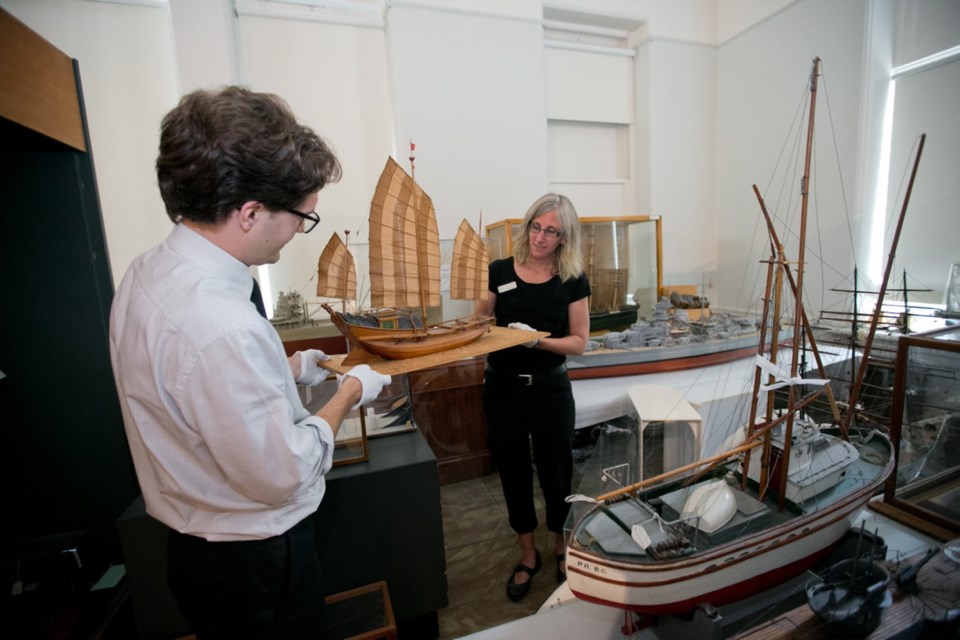The Maritime Museum of British Columbia is excited its new Inner Harbour location will bump it into a bigger league, comparable to the Royal B.C. Museum.
Jon Irwin, executive director of the Maritime Museum, said when his organization has moved and stepped up a notch, it will be able to seek and host exhibits from institutions such as the Canadian Museum of History in Ottawa. The federal museum has a program of lending artifacts to institutions across Canada, but the existing Maritime Museum doesn’t qualify because it lacks climate control.
Now “we just don’t fall into the Royal B.C. Museum class where in Ottawa they would just say: ‘Oh yeah, you guys want to borrow things? I’m sure we can work something out, you meet all the requirements,’” Irwin said.
“Here [at 28 Bastion Square] there is no chance; we just don’t have the climate control,” he said.
“We have no humidity control. Our ventilation system means we open and close the windows.”
The Maritime Museum of B.C. closes on Tuesday. The collection of 40,000-odd artifacts and documents will be moved into one of two newly leased facilities.
For cataloguing, storage, restoration and study, the collection will be placed in 20,000 square feet of enclosed, climate-controlled space rented from the provincial government at 4000 Seymour Place.
But for display to the public, portions of the collection will be exhibited in 6,500 square feet of newly renovated space in the old CPR Steamship Terminal, 470 Belleville St.
At first glance, it might appear the Maritime Museum is losing space, as the Bastion Square building could lay claim to 18,000 square feet, but the extra storage more than makes up for any perceived loss. Also, between current storage needs and quirky layout of the old building, a former courthouse and city hall, exhibit space truly only amounts to about 10,000 square feet.
Kasey Lee, conservation manager at the Royal B.C. Museum, said the ability of any museum to control its interior environments, particularly relative humidity, the level of airborne moisture compared to temperature, is crucial for the proper preservation of historic artifacts.
Lee said controlling atmospheric humidity is essential for restrained, stretched objects, such as First-Nations drums or even paintings on canvas. Also, metal objects are susceptible to corrosion unless humidity and temperature are controlled.
“The basis of any preservation program is preventative,” Lee said. “That means preventing deterioration before it happens.”
So, she said, when it comes to lending portions of their collections, reputable museums will put as much importance on a borrower’s atmospheric controls as upon their fire control and security measures.
The move to the Inner Harbour will also situate the Maritime Museum of B.C. on the water, something every other notable maritime museum in the world offers.
The new exhibit space is not just next to the water on Belleville Street. It will directly face the water and will be on the same level as the Inner Harbour’s causeway.
This means the Maritime Museum’s signature exhibits, such as the Dorothy, built in 1897 in Victoria and recognized as the oldest, privately owned sailboat in Canada, will be able to berth right alongside the museum. The vessel is under restoration on Gabriola Island
Also able to take an adjacent water berth will be the Trekka, built in 1954 and the smallest vessel ever to circumnavigate the globe.
Being on the water will also allow the Maritime Museum of B.C. to play host to notable ships and boats whose bottoms will allow them entry into the Inner Harbour.
So it’s hoped the museum might form part of a classic boat show, or play host to some tall ships.
Finally, officials from the Royal B.C. Museum, the Maritime Museum of B.C. and the Robert Bateman Centre, with its wildlife art, are hoping to form a kind of “cultural precinct” in the area.
“We are definitely in support of [the Maritime Museum’s] move,” said Sandy Pratt, vice-president of business development at the Royal B.C. Museum.
“We hope there will be a synergy happening and the development of a cultural precinct in this area of the Inner Harbour,” Pratt said.
Perhaps the only downside to the move is the fate of the Maritime Museum’s current building in Bastion Square. The provincial government, which owns it, is considering the issue.
Opened in 1889, the building was Victoria’s courthouse, taking over from a log structure. In 1962, the law courts moved out. In 1965, it became home to the Maritime Museum of B.C.
The building still houses the oldest, continuously used birdcage elevator in North America. Installed in 1899, the elevator was ranked No. 2 in National Geographic’s Top 10 Elevator Rides in the World, after the CN Tower in Toronto at No. 1, but ahead of the Empire State Building at No. 4.
“It’s a lovely old building, but it’s 125 years old,” said John West, chairman of the board of trustees of the Maritime Museum.
“This museum has been around now for 60 years and it has continuously punched above its weight,” West said. “So this move might make us a little smaller but it will effectively allow us to offer a more interesting experience.”
